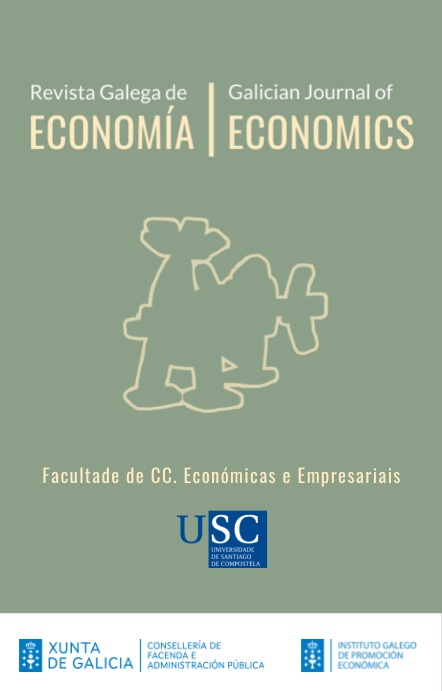Identidade propia e industrias creativas e culturais. O caso das rexións europeas.
Contido principal do artigo
Resumo
Neste artigo analizamos o impacto que ten a identidade cultural e a autonomía política na capacidade das rexións europeas para desenvolver o sector das industrias creativas e culturais. En primeiro lugar, facemos unha recompilación da literatura existente sobre os factores clave para explicar a aglomeración das ditas industrias. En segundo lugar, presentamos as nosas hipóteses sobre o efecto da identidade propia nas industrias culturais e creativas. A continuación, mostramos catro modelos econométricos que relacionan estes conceptos no caso das rexións europeas. Finalmente, expoñemos as principais conclusións do traballo, que poden resumirse na existencia dun impacto positivo da identidade propia no desenvolvemento das industrias creativas e culturais nas rexións europeas.
Palabras chave
Detalles do artigo
Citas
Aguiar, E. (2014). Las industrias culturales y creativas en España. UAM-Accenture Working Paper #2014/13. Madrid: Universidad Autónoma de Madrid. Recuperado de: https://www.academia.edu/29627520/LAS_INDUSTRIAS_CULTURALES_Y_CREATIVAS_EN_ESPA%C3%91A
Amores, J. A. B., Salas, D. P., Melián, J. M. B., y Martínez, C. S. (2016). La clase creativa. Una aproximación a la realidad Española. Revista Internacional de Sociología, 74(2). DOI: http://dx.doi.org/10.3989/ris.2016.74.2.032
Baier, E., Kroll, H., y Zenker, A. (2013). Regional autonomy with regard to innovation policy: A differentiated illustration of the European status quo. Working Papers Firm and Region No. R/2013. Karlsruhe, Germany: Fraunhofer Institute for Systems and Innovation Research ISI. DOI: http://dx.doi.org/10.13140/RG.2.2.21183.51366
Bernal, C. A., Blanco, C. E., Camacho, F., y Díaz, M. (2018). Industrias creativas y culturales: estudio desde el enfoque de la gestión del conocimiento. Información Tecnológica, 29(3), 15-28. DOI: http://dx.doi.org/10.4067/S0718-07642018000300015
Boix, R., Lazzeretti, L., Capone, F., De Propris, L., y Sánchez, D. (2010). The geography of creative industries in Europe: A comparison analysis in Italy, France, the United Kingdom, Spain and Portugal. 50th Congress of the European Regional Science Association: "Sustainable Regional Growth and Development in the Creative Knowledge Economy". Jönköping, Sweden, 19-23 August 2010. Louvain-la-Neuve, Belgium: European Regional Science Association (ERSA). Recuperado de https://www.uv.es/raboixdo/references/2010/10007.pdf
Boix, R., Capone, F., De Propris, L., Lazzeretti L., y Sánchez, D. (2016). Comparing creative industries in Europe. European Urban and Regional Studies, 23(4), 935-940. DOI: https://doi.org/10.1177/0969776414541135
Boschma, R. A., y Fritsch, M. (2009). Creative class and regional growth: Empirical evidence from seven European countries. Economic Geography, 85(4), 391-424. DOI: https://doi.org/10.1111/j.1944-8287.2009.01048.x
Escolano, S., y Escalona, A. I. (2017). Especialización, concentración y aglomeración espacial de los servicios intensivos en conocimiento en España. Documents d’Analisi Geografica, 63(1), 55-80. DOI: https://doi.org/10.5565/rev/dag.328
European Commission. (2011). Cultural statistics. Luxembourg, Luxembourg: Office for Official Publications of the European Communities. Recuperado de: https://ec.europa.eu/eurostat/documents/3217494/7551543/KS-04-15-737-EN-N.pdf/648072f3-63c447d8-905a-6fdc742b8605
European Commission. (2016). European social progress index. Luxembourg, Luxembourg: Office for Official Publications of the European Communities. Recuperado de: https://ec.europa.eu/regional_policy/en/information/maps/social_progress
Eurostat. (s.f.a). Employment by age, economic activity and NUTS 2 regions. Luxembourg, Luxembourg: Eurostat. Recuperado de: https://appsso.eurostat.ec.europa.eu/nui/show.do?dataset=lfst_r_lfe2en2&lang=en
Eurostat (s.f.b). Population aged 25-64 by educational attainment level, sex and NUTS 2 regions (%). Luxembourg, Luxembourg: Eurostat. Recuperado de: https://appsso.eurostat.ec.europa.eu/nui/show.do?dataset=edat_lfse_04&lang=en
Eurostat (s.f.c). Percentage of R&D expenditure over GDP in the NUTS 2. Luxembourg, Luxembourg: Eurostat. Recuperado de: https://appsso.eurostat.ec.europa.eu/nui/submitViewTableAction.do
Eurostat (s.f.d). Population density by NUTS 3 region. Luxembourg, Luxembourg: Eurostat. Recuperado de: https://appsso.eurostat.ec.europa.eu/nui/show.do?dataset=demo_r_d3dens&lang=en
Florida, R. (2002). The rise of the creative class: Why cities without gays and rock bands are losing the economic development race. The Washington Monthly, May, 15-25. Recuperado de: https://creativeclass.com/wp-content/uploads/2020/07/14%20The%20Rise%20of%20the%20Creative%20Class.pdf
Florida, R. (2005). Cities and the creative class. New York, NY: Routledge. DOI: http://dx.doi.org/10.1111/1540-6040.00034
Florida, R. (2010). La clase creativa: la transformación de la cultura del trabajo y el ocio en el siglo XXI. Barcelona: Paidós.
Friedman, T. L. (2009). The world is flat: A brief history of the twenty-first century. Bridgewater, NJ: Distributed by Paw Prints/Baker & Taylor.
González, M. (2009). Euro commentary: Regional differences in the growth patterns of knowledge-intensive business services: An approach based on the Spanish case. European Urban and Regional Studies, 16(1), 101-106. DOI: https://doi.org/10.1177%2F0969776408098939
González, M., y Fernández, J. (2018). The role of intercultural, scientific and technological openness on innovation in European regions. Innovation: The European Journal of Social Science Research, 31(3), 278-292. DOI: https://doi.org/10.1080/13511610.2017.1348934
Higgs, P., y Cunningham, S. (2008). Creative industries mapping: Where have we come from and where are we going? Creative Industries Journal, 1(1), 7-30. DOI: https://doi.org/10.1386/cij.1.1.7_1
In Grant, J. (2014). Seeking talent for creative cities: The social dynamics of innovation. Toronto, Canada: University of Toronto Press. DOI: https://doi.org/10.3138/9781442667938
Kenney, M. (2003). Understanding Silicon Valley: The anatomy of an entrepreneurial region. Stanford, CA: Stanford University Press.
Lins, H. N. (2011). Economía da cultura e ambiente urbano: termos do debate e ensaio de análise sobre Florianópolis. Revista Paranaense de Desenvolvimento, 120, 231-256. Recuperado de: https://dialnet.unirioja.es/servlet/articulo?codigo=3990157
Lorenzo, M. (2017). As políticas culturais en Galicia. Grial: Revista Galega de Cultura, 55(215), 61-73. Recuperado de: http://interaccio.diba.cat/sites/interaccio.diba.cat/files/las_politicas_culturales_en_galicia_es_pt_marcos_lorenzo_0.pdf
Mahon, T., y Riambau, E. (1995). Las gentes de Silicon Valley: una comunidad que ya vive el futuro tecnológico. Barcelona: Planeta De Agostini.
Maroto, R., y Cabrerizo, C. (2013). La geografía de las industrias culturales y creativas en Europa. Madrid: Fundación Ideas. Recuperado de https://dialnet.unirioja.es/servlet/libro?codigo=572418
Real Academia Galega. (s.f.a). Creatividade. En Real Academia Galega: Dicionario da Real Academia Galega. Recuperado de: https://academia.gal/dicionario/-/termo/busca/creatividade.
Real Academia Galega. (s.f.b). Creativo/a. En Real Academia Galega: Dicionario da Real Academia Galega. Recuperado de: https://academia.gal/dicionario/-/termo/busca/creativo.
Renaud, O., y Victoria-Feser, M. (2010). A robust coefficient of determination for regression. Journal of Statistical Planning and Inference, 140(7), 1852-1862. DOI: https://doi.org/10.1016/j.jspi.2010.01.008
Rey, G. (2009). Industrias culturales, creatividad y desarrollo. Madrid: Agencia Española de Cooperación Internacional para el Desarrollo. Dirección de Relaciones Culturales y Científica. Recuperado de: http://www.lacult.unesco.org/docc/2009_Ind_Cult_CreativyDes_AECID.pdf
Tur-Viñes, V., García-Medina, I., e Hidalgo-Marí, T. (2018). Creative industries global conference. Proceeding Book. Alicante: Universidad de Alicante, Derpartamento de Comunicación y Psicología Social. DOI: http://dx.doi.org/10.14198/MEDCOM/2017/12_cmd
United Nations. (2010). Creative economy Report 2010 – Creative economy: A feasible development option. New York, NY: United Nations. Recuperado: de https://unctad.org/en/Docs/ditctab20103_en.pdf
Vence, X., y González, M. (2005). Los servicios intensivos en conocimiento, especialización y crecimiento en Europa. ICE, Revista de Economía, 824, 117-137. Recuperado de http://www.revistasice.com/index.php/ICE/article/view/810/810
Vence, X., y González, M. (2014). Regional concentration of knowledge-intensive business services in Europe. Environment and Planning. C, Government and Policy, 32(6), 1036-1058. DOI: https://doi.org/10.1068%2Fc11171r







